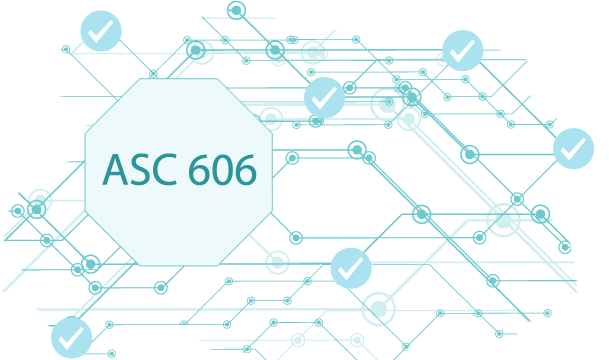ASC 606 revenue recognition directs organizations to recognize revenue when the promised goods or services are transferred to the customer. The amount of revenue recognized should equal the total consideration an organization expects to receive in return for the goods/services. Essentially, the revenue recognition principle states that revenue can only be recognized once it has been earned – not necessarily when payment is received.
Let’s look at a couple of revenue recognition examples so we can understand it more. Say your landscaping business completes the tree trimming of a housing development and sends the client an invoice for $4,000. With the contractual obligation met, you can recognize the $4,000 immediately – even though payment won’t be received until the following month.
Using the same landscaping revenue recognition principle example, we’ll add a twist to the scenario. At the start of each quarter, the client pays $1,000 in advance. Can the company recognize the $1,000 as soon as it’s received? The short answer is no. However, since the client is paying $1,000 in advance of services being rendered, the company can recognize $1,000 per quarter. They still must ensure that the quarterly services are complete first though.
What is Revenue Recognition (RevRec)?
As mentioned above, GAAP revenue recognition (aka generally accepted accounting principle) outlines when and how companies recognize revenue. Across all industries and business models, knowing when to recognize revenue is challenging. To establish best practices, eliminate confusion and standardize the recognition of revenue, the Financial Accounting Standards Board (FASB) and International Accounting Standards Board (IASB) developed a framework – Accounting Standards Codification (ASC 606) – for more consistent revenue recognition. The goal is to attribute revenue and related expenses to the correct accounting periods, reflecting an accurate financial picture.
However, challenges abound. Revenue complexities—such as varying contract terms, timing uncertainties, and discrepancies—can complicate the process. Nearly 40% of finance leaders report spending significant time correcting RevRec errors, which can impact financial reporting and decision-making.
Ensuring accuracy and consistency by standardizing revenue recognition practices is key. Revenue should be recognized when it is earned and realizable, even if payment occurs later. By addressing timing differences and following established guidelines, businesses can maintain compliance and provide reliable financial insights.
Why ASC 606 Compliance Matters for Business
ASC 606 compliance ensures that revenue recognition aligns with the actual delivery of goods or services. This is critical to preventing early or delayed recognition that can skew your financial performance. By adhering to formal revenue recognition methods, businesses can standardize their RevRec process. This facilitates easier comparison of financial statements and providing reliable guidance for stakeholders.
This standardization is especially beneficial for public companies, startups, and subscription- or service-based businesses. For public companies and businesses earning over $25 million annually, compliance is a legal requirement under GAAP and IFRS, while startups need it to meet accrual accounting principles vital for fundraising or loan applications.
The revenue recognition deferral approach, often used in the software industry, is a key example of revenue recognition in practice. With ratable revenue recognition, businesses handling prepaid subscriptions can accurately recognize revenue over the service term.
Following the 5 steps of revenue recognition, businesses can ensure consistency and transparency, enhancing informed decision-making for investors and analysts.
The Four W’s of ASC 606 Revenue Recognition
While RevRec is complicated and has its fair share of nuances, it can be explained using the four W’s – who, what, when, and why.
Who:
ASC 606 revenue recognition affects virtually all companies or entities – public, private, and non-profit – that enter into contracts with customers for the transfer of goods or services, or enter into contracts for the transfer of specific nonfinancial assets.
What:
ASC 606 provides businesses and entities with a universal framework for recognizing revenue from the sale of goods and services. It focuses on the promises documented in the contract to ensure that revenue is only recognized when contractual obligations have been met. To help organizations adhere to the principles, the standard provides a five-step process for revenue recognition.
1) Identify the contract
This is the agreement between the company and the client and contains obligations and rights that can be enforced by either party if/when necessary. The essential components of the contract are:
- All parties have approved the contract
- All parties are committed to fulfilling their obligations
- Each party’s rights are identifiable
- Payment terms are identified
- The contract has commercial substance
- Collectibility is probable
2) Identify the performance obligation
This is the promise to transfer goods to the customer or complete contractual services. According to IFRS 15.27, a good or a service is distinct if both of the following are met: The good or service is capable of being distinct. This means that the customer can benefit from it either on its own or together with other available resources. The good or service is distinct within the context of the contract.
3) Determine the transaction price
This step refers to the cash and non-cash a company expects to receive in exchange for the transferring of the promised goods or services. The amount can be fixed, variable, or a combination of both and may include other considerations such as upgrades, downgrades, price concessions, volume discounts, rebates, etc. The allocated amounts are recognized as revenue when (or as) performance obligations are met.
4) Allocate the transaction price
When a contract contains more than one performance obligation, the company needs to allocate the total consideration to each performance obligation based on its relative standalone selling price. We should note that ASC 606 doesn’t prohibit any methods used for estimating the standalone selling price, as long as the estimate is an accurate representation of what the price would be if it were a separate transaction. This step is a bit more complicated for software-as-a-service (SaaS) companies since their products or services are delivered on a recurring basis.
5) Revenue recognition
The final step, revenue is recognized when or as the performance obligations stated in the contract are fulfilled. Satisfying performance obligations can happen either at a specific moment or over a period of time.
When:
In May 2014, the FASB and IASB jointly issued Accounting Standards Update (ASU) 2014-09, which introduced ASC 606. It highlights how revenue received from contracts is treated and provides a uniformed framework for recognizing revenue.
Why:
ASC 606 revenue recognition was developed for a variety of reasons, including to:
- Remove inconsistencies and weaknesses in revenue requirements.
- Provide a robust framework for addressing revenue issues.
- Improve comparability of revenue recognition practices across entities, industries, jurisdictions, and capital markets.
- Provide useful information to financial statement users through improved disclosure requirements.
- Simplify the preparation of financial statements by reducing the number of publications.
- Eliminate differences between GAAP and IFRS.
- Add transparency to financial reporting.
Adhering to ASC 606 has many nuances and amendments continue to be made. However, the fact remains – ASC 606 compliance is mandatory. To overcome pitfalls and comply with this revenue recognition standard, companies need a way to streamline their financial processes and ensure accuracy.
Transform Your RevRec Processes
At its core, getting ASC 606 revenue recognition right requires intelligent software that delivers revenue recognition automation, accuracy, and auditability. Obtaining the right revenue recognition solution shouldn’t be left to chance. To help you select the solution that will best meet your revenue recognition needs, here are four key characteristics the software should provide.
- Contract management: Ensure the billing solution easily manages contract rates and payment terms, as well as provides the ability to set specific pricing, define rules and create account hierarchies.
- Flexible data models: An extensible data model enables you to add objects, fields, and relationships, as well as apply business rules to support any monetization model. A flexible data model allows you to quickly modify the application and data structure to respond to market or regulatory changes.
- Seamless integration: By integrating your billing, revenue recognition, customer relationship management (CRM), enterprise resource planning (ERP), general ledger, etc. systems, data is seamlessly shared between applications – eliminating the need for manual data entry, reducing or eliminating duplicate entries, and lessening manual, error-prone financial tasks. A fully integrated financial ecosystem provides a single source of the truth, helping to ensure accurate revenue recognition.
- Global compliance: A billing solution that delivers regulatory compliance ensures your company meets all accounting standards and that revenue recognition complies with ASC 606 mandates.
The right revenue recognition platform helps you simplify revenue recognition complexities – even for the most complex billing scenarios. BillingPlatform’s rules-based revenue recognition engine enables you to define rules specific to your company. You can then make assignments in real time, while providing the agility needed to speed the financial close process with real-time subledger transactions that integrate into downstream ERP and accounting systems.
Are you ready to transform your revenue recognition processes? Our team of experts are just a click away.



